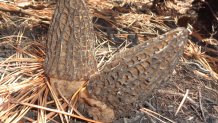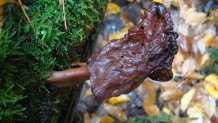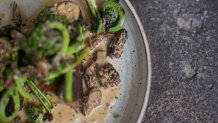We've heard that taking an "awe walk" through nature can work wonders for your mental health. What about a nature walk where you can bring dinner — or at least a snack — back home with you?
In many parts of the country, you can find morel mushrooms from mid-to-late April and into May. But not everyone knows what these mushrooms are, how to find them, or how to avoid their scary fungal brethren.
So we talked with Andrew Miller, a mycologist (editor's note: mushroom scientist) at the Illinois Natural History Survey and professor at the University of Illinois Urbana-Champaign.
Here's what Miller says you can do to find some tasty treats, courtesy of Mother Nature — and how not to get sick while doing so.
Where to Hunt, Forage for Mushrooms
Your best bet is an older wooded area, maybe with some shade and moisture.
When Miller goes out and looks for morel mushrooms, he's looking up, not down, to spot dead or dying elm trees. If the bark is loosening and flaking off, that's a bad sign for the tree, and a good sign for you — go check around the tree's base there. This is a little easier than checking the base of every tree you see.
As a tree dies, you'll see mushrooms produce their "fruit" (the part we eat, as opposed to the mycelium, which is like roots) as a way to spread spores and continue the shroom life cycle.
"Morels obviously don’t have wings and they can’t fly away, they don’t have legs and they can’t run away. If you’re forming an association with a tree and getting sugars from that tree, you want to get out of there when that tree starts to die," Miller said.
"The morel figures out, ‘this tree is dying and I’ve got to get out of here.’ So the only way it can do it is produce these fruiting bodies, the morels that we like to go out and pick."
That said, Miller has also heard of morels being found under pine trees and next to asphalt driveways. His wife once found a morel in their peony flower bed at home. So if you're not heading to the woods, observe your surroundings where you are and maybe you'll still find something.
Get permission!
Where are you going to go look for the mushrooms? You might have heard a tip on a good location from a local mushroom forager if they were nice! But those who sell to restaurants might not want to blow up their best spots.
Wherever you're going, just make sure you're not trespassing on private property and that it's ok to pick there.
Even if the pickings are good, you don't want to get in trouble.
State parks in your state might allow for mushroom hunting; you can check local sites to be sure. (You can in Illinois, Miller says.) National parks might be less hospitable to your shroom-gathering.
What do morel mushrooms look like?

Morel mushrooms have a pockmarked texture sort of like a sponge. They can be a light brown color or a little darker like these shown above.
One sure way to test if you've got a morel: cut it open. There should be a narrow, hollow stem running down the length of the mushroom, Miller said. If it's solid, it's something else.
When you pick these, watch out for pieces of dirt or little bugs that might hitch a ride in those little divets.
What do poisonous false morels look like?
If you are the adventurous type and you're looking for some sort of out-of-body experience from a mushroom, do not look to the false morel.
If you eat one, you'll have an experience, alright — one that will make you very aware of your body and its functions.
"You're probably going to experience a lot of vomiting and diarrhea for a couple days, and then your immune system will kick in...It's just going to be an unpleasant experience," Miller said.

Some people do eat false morels after thorough washing, under the belief that removes all the toxin. But small amounts could still build up in your body and make you sick the next time, so it's best to avoid the risk: these are not recommended eats.
A good tip for any mushroom you're not 100% sure about: don't eat it. See if you can find a knowledgeable person to identify what species you have and if it's safe.
Prepare and cook your mushroom harvest
Your first step should be to cut the mushrooms and make sure they have hollow stems like morels should. Then it's a good idea to brush out or lightly wash them, you don't want to eat dirt — or little bugs.
Some restaurants serve the mushrooms with other foraged ingredients like the fiddlehead fern.

Miller recommends keeping it simple, and not overwhelming the morel's flavor with a heavy sauce or a lot of spices.
"It's going to take away from the taste of the mushroom if you really like that mushroomy taste."
He likes to lightly sauté them in a pan with butter and have that as a side. So probably no morel mushroom pizzas or omelets.
"We don't really do anything fancy, we'll have them with a side of eggs or an omelet or something, but we wouldn't necessarily put them in with another food," Miller said.

